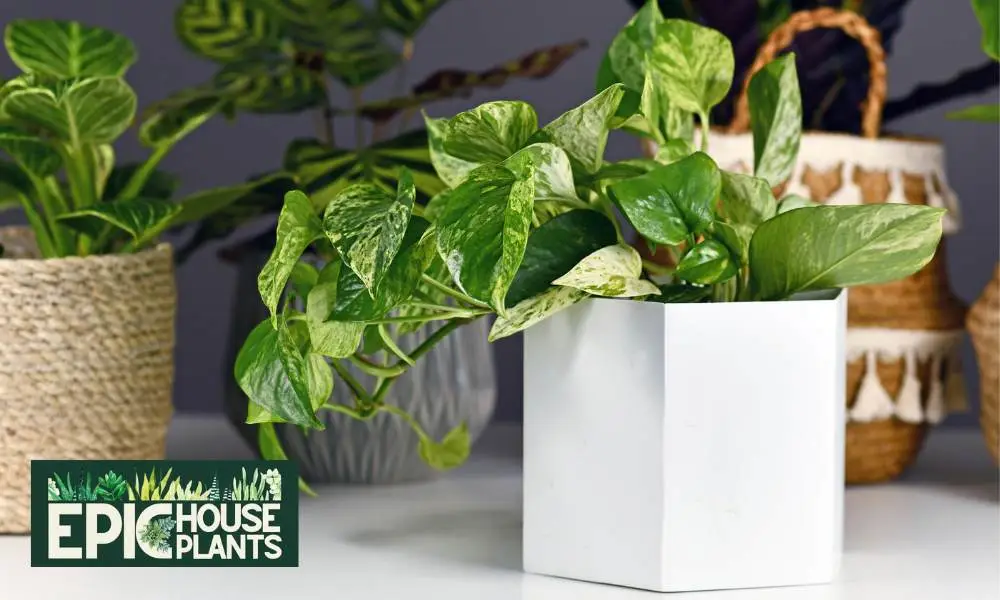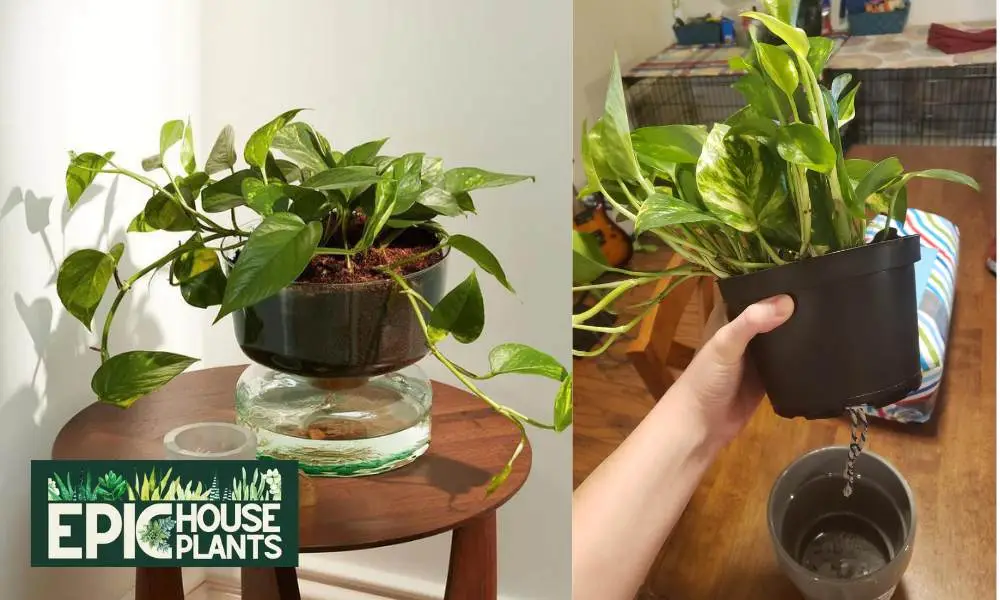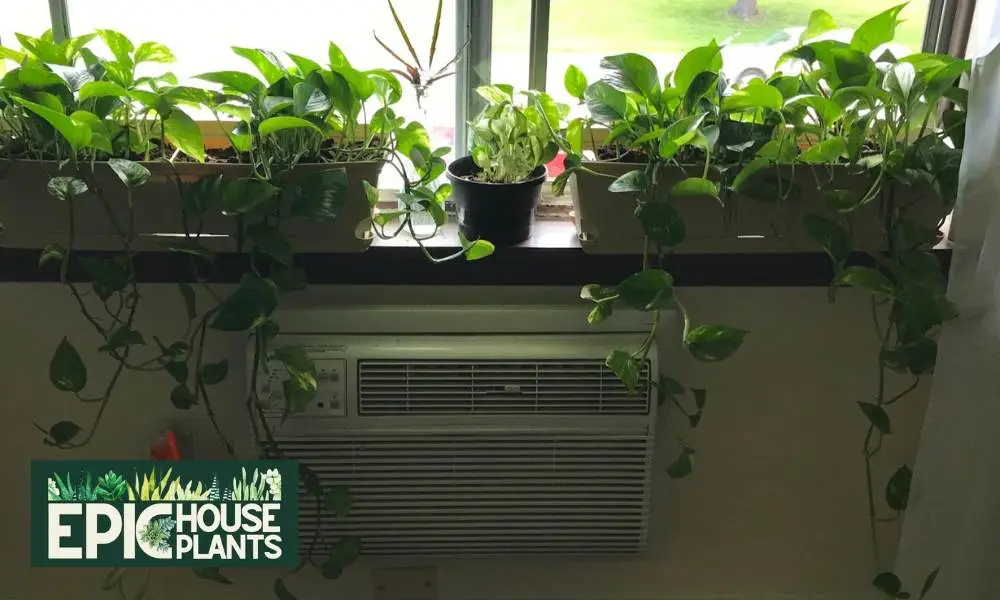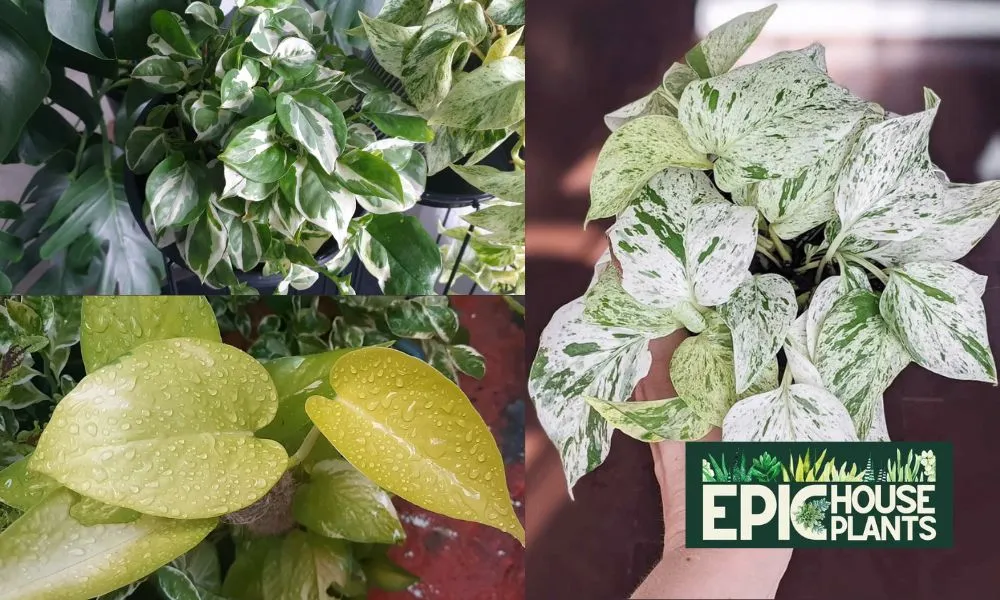The pothos plant, also known as Epipremnum aureum, is a real gem when it comes to houseplants. It’s low-maintenance, adaptable to various conditions, and adds a touch of beauty as it cascades from shelves or climbs moss poles
However, finding the perfect pot for your pothos can be a bit overwhelming with all the options out there. Don’t worry, though!
This guide will walk you through everything you need to consider, from materials and drainage to size and aesthetics. By the end, you’ll feel confident in selecting a pot that will help your pothos thrive for years to come. Let’s get started!

Factors to Consider When Choosing the Best Planter for Pothos
If you’re looking for the perfect planter for your Pothos plant, there are a few things you should keep in mind. Let’s go through them together in a friendly and helpful tone.
Material
Terracotta and clay pots are great options because they allow the soil to breathe and prevent water from getting stagnant. This helps to avoid root rot, which can be a common issue for Pothos plants.
However, keep in mind that these pots can dry out quickly, so you’ll need to water your plant more often. If you’re not able to water your plant regularly or if the humidity in your environment is low, plastic or ceramic pots might be a better choice. They retain moisture for longer periods and are also lighter and more resistant to breakage.
Climate Considerations:
- Hot, dry climates: Opt for moisture-retaining materials like terracotta or ceramic.
- Cool, humid climates: Choose more breathable pots like plastic or metal to prevent moisture buildup.
Pot Size
Choosing the right pot size is important for the health and growth of your Pothos plant. A pot that’s too small can restrict the root system and cause stress and dehydration.
On the other hand, a pot that’s too large can hold too much moisture, increasing the risk of root rot. Aim for a pot that’s slightly larger than the root ball of your Pothos, allowing room for growth without retaining excess water.
Aim for a pot that’s 1-2 inches wider than the root ball of your pothos. Too big can lead to root rot, while too small restricts growth.
Author Note:
To ensure the optimal health and growth of your Pothos plant, it is crucial to select the right pot size, avoiding the issue of a rootbound Pothos, which can lead to stress and dehydration.
Drainage
Good drainage is crucial for your Pothos plant’s well-being. Make sure the pot you choose has adequate drainage holes at the bottom. This allows excess water to escape, preventing waterlogging and root rot.
If you have a decorative pot without drainage holes, you can use it as a cover pot and place a functional, drainable pot inside. Adding a layer of gravel or broken pottery pieces at the bottom of the pot can also improve water flow, especially for non-porous materials like plastic or ceramic.
Indoor vs. Outdoor
Consider the climate and location where you’ll be keeping your Pothos plant. If it’s going to be outdoors, choose pots that can withstand your local climate, such as frost-resistant pots for colder areas. In hot and dry climates, porous pots might dry out too quickly, so non-porous pots could be a better option.
If you live in a humid and cooler climate, non-porous pots can help prevent overwatering. To improve drainage and prevent waterlogging in outdoor pots, you can use pot feet or risers, especially in rainy climates.
Style and Decor
Lastly, let’s talk about style and decor. While the health of your Pothos plant is important, it’s also nice to choose a pot that complements your personal style and the surrounding decor. Terracotta pots offer a classic and rustic look that suits various settings.
On the other hand, ceramic and plastic pots come in a wide range of colors, shapes, and designs, allowing for more customization to match your preferences and interior design. Choosing a pot that you love will not only make your Pothos plant happy but also enhance the overall appearance of your home or office.
Placement Plays a Role:
- Hanging: Macrame hangers, ceramic hanging planters, or metal hanging baskets are ideal.
- Shelves: Wall-mounted planters, climbing moss poles, or tiered shelf planters create vertical interest.
- Tabletop: Classic ceramic pots, terracotta pots.
Additional Tips:
- Consider lightweight options like plastic if you have limited mobility.
- Choose ceramic or metal if you have pets or children.
- Pots range in price, so set a budget before shopping.
Types of Pots Based on Material
Are you on the hunt for the perfect pot for your beloved pothos plants? Well, look no further! We’ve got you covered with a rundown of different pot materials and their pros and cons. Let’s dive in!
Terracotta or Clay Pots: Timeless and Breathable

These classic pots are a timeless choice for a reason. Terracotta is porous, allowing soil to breathe and water to evaporate, which helps prevent root rot. However, keep in mind that they can dry out quickly, so you might need to water your plants more often, especially in warm and dry climates.
Plastic Pots: Lightweight and Versatile

Looking for something lightweight and versatile? Plastic pots are a popular option. They retain moisture better than terracotta, which can be great for pothos. However, they don’t offer the same breathability, so make sure they have proper drainage holes to avoid water buildup.
Ceramic Pots: Beautiful and Breathable

If you’re after pots that are as beautiful as your pothos, ceramic pots are the way to go. They often come in stunning designs and colors.
Like terracotta, they are breathable, but they usually have a glaze that slows down moisture loss. These pots are a bit heavier, which can provide stability for tall or top-heavy plants.
Concrete Pots: Durability and Modern Aesthetic

For those who crave durability and a modern aesthetic, concrete pots are a fantastic choice. They offer good insulation for the soil, regulating its temperature. However, keep in mind that they can be heavy to move, especially in larger sizes.
Wooden Pots: Natural and Rustic Charm

If you want to add a touch of nature and rustic charm to your space, wooden pots are perfect. They are generally breathable and offer moderate insulation for the soil.
Just be cautious about constant moisture, as wood can rot over time. Ensure they have good drainage and consider using a liner to protect the wood.
Metal Pots: Sleek and Contemporary

Are you into sleek and contemporary looks? Metal pots are a great option. They are durable and come in various finishes and styles.
However, be aware that metal can conduct heat, potentially overheating the soil on hot days. Also, make sure they have drainage holes, as metal is not breathable.
Fiberglass Pots: Lightweight and Durable

Looking for a lightweight alternative that mimics the appearance of heavier materials? Fiberglass pots are your go-to! They are weather-resistant and durable, making them suitable for both indoor and outdoor use.
Fabric Pots: Good Drainage and Air Circulation

For those who prioritize good drainage, air circulation, and portability, fabric pots are a compelling choice. They promote air pruning of roots, leading to healthier plants. Just keep in mind that they may require more frequent watering due to increased airflow.
Author Note:
When selecting a pot material, consider your plant’s specific needs, the climate you live in, and the style of your space. Each material offers its own unique benefits and drawbacks. So, find the perfect balance between functionality, style, and the environmental requirements of your pothos plants.
Types of Pots Based on Watering System
If you’re looking for the perfect pot for your pothos, you’ll be happy to know that there are different types available based on their watering systems.
Each type is designed to cater to different needs, making it easier for you to take care of your plants. Let’s dive in and explore the options:
Standard Pots with Drainage Holes

These are the most common types of pots you’ll come across. They have holes at the bottom to allow excess water to escape. This is great because it prevents overwatering and root rot. Plus, they work well for a wide range of plants, including those with specific drainage requirements.
Advantages:
- The drainage holes prevent overwatering and root rot.
- Suitable for various plants with different drainage needs.
Disadvantages:
- You’ll need to keep an eye on watering schedules to ensure your plants are getting enough water.
- Without a saucer, water draining out can create a mess.
Self-Watering Pots

If you’re a busy bee or tend to forget about watering your plants, self-watering pots are a game-changer. These pots have a water reservoir at the bottom, which provides a steady supply of water to the soil through capillary action or wicking.
This means you won’t have to water your plants as frequently, making it perfect for those with a busy lifestyle.
Advantages:
- The water reservoir reduces the need for frequent watering.
- Ideal for busy individuals or when you’re away on vacation.
Disadvantages:
- If not monitored, they can lead to overwatering for plants that prefer drier soil.
- The reservoir needs occasional cleaning to prevent algae growth and ensure proper functioning.
When choosing a pot based on its watering system, it’s important to consider your plant’s specific needs, your availability to water and maintain them, and the level of setup you’re comfortable with.
While some systems offer convenience and efficiency, they may require more initial investment or knowledge. On the other hand, standard pots with drainage holes remain a versatile and straightforward choice, but they do require more attention to watering schedules.
Types of Pots Based on Function
Different types of pots serve different functions, catering to your specific needs and preferences for plant care and display.
By understanding the advantages and disadvantages of each type, you can make informed decisions for your gardening or interior decoration projects.
Let’s take a closer look at the types of pots based on their function:
Standard Pots: The Jack of All Trades

These versatile pots are the most common choice. They usually have drainage holes at the bottom and are suitable for almost all types of indoor plants, including pothos.
You can find them in various materials like plastic, terracotta, ceramic, and metal. The best part? They come in different sizes and designs to suit any preference or plant requirement.
Advantages:
- Perfect for a wide range of plants, from flowers to herbs and small shrubs.
- Easy to find in different materials, sizes, and designs to match your style.
Disadvantages:
- They don’t offer any special features for moisture control or self-watering, so you’ll need to pay extra attention to watering and drainage.
Decorative Pots: Beauty with a Twist

If aesthetics are your top priority, decorative pots are the way to go. They come in various designs, colors, and materials, allowing you to add a touch of style to your space.
Keep in mind that some decorative pots may not have drainage holes, so it’s common to use them as cover pots and place a standard pot inside.
Advantages:
- Available in a wide range of styles to complement your interior design or garden theme.
- Can be used as standalone decorative elements or in combination with functional pots.
Disadvantages:
- Some decorative pots may lack proper drainage holes, which can lead to waterlogging.
- They tend to be more expensive due to their ornamental value.
Nursery Pots: The Early Bloomers

These simple and functional pots are made of plastic and are typically used for growing plants before they are transplanted.
They are lightweight, affordable, and have good drainage, making them ideal for the initial stages of pothos growth.
Advantages:
- Designed specifically for the early stages of a plant’s life, with features like drainage holes and lightweight material for easy handling.
- Generally inexpensive and reusable, making them a practical choice for propagation.
Disadvantages:
- Usually not designed for long-term display, lacking decorative features.
- Made from lightweight materials that may not withstand harsh weather or long-term use without damage.
Each type of pot serves a different purpose, so the choice depends on your specific needs, the space where the plant will be placed, and the overall aesthetic you’re aiming for in your home or office. Happy pot shopping!
Types of Pots Based on Placement
Let’s explore the different types of pothos pots based on placement, each offering unique advantages and considerations:
Hanging Pots: Hang in there!

Pothos plants, with their beautiful trailing vines, look stunning in hanging pots. These pots allow the vines to cascade down, making them perfect for vertical space utilization. You can hang them from ceilings, brackets, or wall hooks.
Advantages:
- Great for small spaces, as they allow plants to be displayed vertically.
- Offers unique decorative possibilities, especially for trailing plants like pothos or spider plants.
Disadvantages:
- Watering can be a bit tricky, especially for indoor setups.
- Usually smaller in size, limiting the growth potential of your plant.
Wall-Mounted Pots: Take your pothos to new heights!

These pots are designed to be mounted on walls, saving floor space and adding to your decor. They are perfect for creating a living wall effect with your pothos plants.
Advantages:
- Excellent for adding greenery to walls, saving floor and shelf space.
- Can be used to create a living wall or vertical garden.
Disadvantages:
- Installation may be permanent or require drilling, so it might not be suitable for all living situations.
- Watering can be a bit tricky without proper systems in place, potentially leading to water damage on walls.
Window Sill Pots: Let the sunshine in!

Long and narrow, these pots are designed to sit on window sills. They’re great for growing pothos in a linear arrangement, allowing the vines to trail down and maximize limited space and sunlight exposure.
Advantages:
- Ideal for apartment dwellers or those with limited garden space, as they allow for gardening on windowsills or balconies.
- Adds charm and color to window areas, improving curb appeal.
Disadvantages:
- Plants may be more exposed to wind or extreme weather, requiring more frequent watering and care.
- The weight of the box and soil can be a concern, so make sure to secure them properly.
Floor Pots: Make a statement!

Larger and more stable, these pots are designed to sit on the floor and can accommodate larger pothos plants or multiple small ones grouped together. They’re perfect for filling empty corners or serving as statement pieces in a room.
Advantages:
- Suitable for larger plants, making them a statement piece in home or office decor.
- Can be used to fill empty spaces and bring greenery to room corners or large open areas.
Disadvantages:
- Can be heavy and difficult to move, especially when filled with soil and a large plant.
- Require space, so they might not be ideal for small apartments or crowded rooms.
Desktop Pots: Bring nature to your workspace!

Smaller in size, these pots are perfect for placing on desks, shelves, or tabletops. They usually have a compact design suitable for small pothos plants or cuttings.
Advantages:
- Perfect for small plants, adding a touch of nature to workspaces without taking up much room.
- Can help improve mood and productivity when placed within sight on desks or tables.
Disadvantages:
- Limited in size, which can restrict plant growth or the variety of plants you can choose.
- Risk of water damage to furniture if pots leak or are overwatered without proper protection.
When choosing a pot based on placement, consider not only the aesthetic and space requirements but also the practical aspects of plant care, such as ease of watering, light needs, and temperature conditions.
Pothos’ adaptability makes it a fantastic plant for experimenting with different placements and pot types, allowing for creative and flexible greenery arrangements in any setting. So go ahead, find the perfect pot for your pothos and watch it thrive!
What Types of Pot Shouldn’t I Choose for My Pothos?
When choosing planters for Pothos plants, there are certain types you might want to avoid to ensure the health and well-being of your plant.
Here are the potential problems and solutions in table format:
| Potential Problem | Solution |
|---|---|
| Pots Without Drainage Holes | Consider drilling drainage holes yourself or use it as a decorative outer pot with a functional inner pot. |
| Oversized Pots | Choose a pot that’s just slightly larger than the root ball of the plant. |
| Non-Breathable Materials in Humid Climates | Opt for more breathable materials like terracotta or unglazed ceramic to allow for better air flow and moisture evaporation. |
| Very Shallow or Very Deep Pots | Opt for a medium-depth pot that provides adequate space for root growth without encouraging water accumulation. |
| Metal Pots in Direct Sunlight | Choose a material that doesn’t conduct heat as much when placing the plant in a spot with a lot of sunlight. |
| Pots with Rough Interior Surfaces | Choose pots with smooth interiors to facilitate easier and safer repotting. |
| Decorative Pots Without Proper Functionality | Ensure the pot meets the functional needs of your Pothos, including adequate drainage and suitable materials. |
FAQs
What if my Pothos pot is too big?
Your Pothos may be at risk of overwatering and root rot because the excess soil retains more moisture than the plant can use. Consider repotting it into a slightly smaller pot that’s more proportionate to the size of its root ball.
How do I know if my Pothos needs a bigger pot?
Signs your Pothos needs a bigger pot include roots growing out of the drainage holes, soil drying out too quickly, or visible root circling at the surface of the soil.
Are terracotta pots better than plastic pots for Pothos?
Terracotta pots are generally better for Pothos because they allow the soil to breathe and help prevent overwatering by wicking away excess moisture. However, plastic pots can be suitable in situations where retaining moisture is necessary due to low humidity or infrequent watering.
Are self-watering pots good for Pothos?
Yes, self-watering pots can be good for Pothos, especially for those who might forget to water their plants regularly. They help maintain consistent moisture levels, which is beneficial for Pothos growth.
Conclusion
Selecting the right pot for your pothos is a delightful blend of practicality and aesthetics. By considering factors like material, size, drainage, climate, and design, you can ensure your pothos not only adds beauty to your space but also grows healthily.
Remember, the right pot is crucial in providing the ideal environment for your plant, making your journey in plant care both successful and enjoyable.
Author

Pudji Haryanto
Pudji Haryanto is a writer and urban farmer with a passion for cultivating plants. He has over 15 years of experience in agriculture and currently manages a 65,000 square foot rice-field and yard filled with various plants, including vegetables, spices, flowers, and garden plants.

